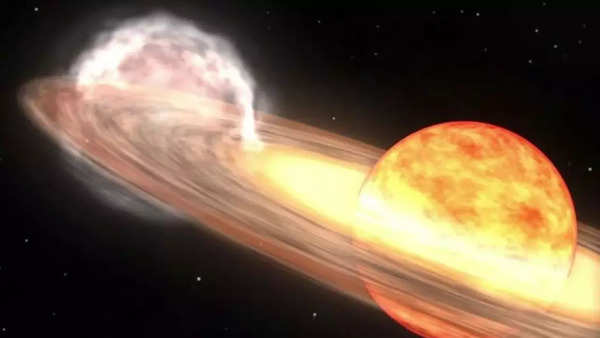The white dwarf, a dense remnant of a dead star, has been steadily drawing hydrogen from its companion, the red giant. Over time, this hydrogen accumulates on the white dwarf’s surface, setting the stage for a dramatic thermonuclear explosion. This event, known as a nova, is expected to be visible to the naked eye, offering a rare opportunity for both professional and amateur astronomers to witness a stellar explosion up close.

Artist’s representation of the white dwarf drawing hydrogen from its red giant companion. Source: NASA
The star at the center of this anticipated event is T Coronae Borealis, also known as the Blaze Star. Its last recorded outburst occurred in 1946, and since then, astronomers have been eagerly awaiting its next explosion. The upcoming nova is predicted to occur between now and September 2024, making it one of the most highly anticipated astronomical events of the year.
Dr. Rebekah Hounsell, an assistant research scientist at NASA’s Goddard Space Flight Center, emphasizes the significance of this event. She notes that such occurrences are infrequent and provide valuable insights into the life cycles of stars. Observing the Blaze Star’s explosion will allow scientists to study the mechanisms behind these powerful events and improve our understanding of stellar evolution.
The Blaze Star’s explosion is expected to be a spectacular sight, with the potential to outshine many of the stars in the night sky. This event will not only captivate astronomers but also inspire a new generation of stargazers. The anticipation surrounding the Blaze Star’s nova highlights the enduring fascination with outerspace and the endless mysteries it holds.
As the predicted date approaches, observatories around the world are preparing to capture every moment of the Blaze Star’s explosion. Telescopes will be trained on the constellation Corona Borealis, ready to record the event in unprecedented detail. This nova will provide a wealth of data for scientists to analyze, contributing to our understanding of the universe.
For those eager to witness this celestial event, it is recommended to keep an eye on updates from NASA and other space observatories. The Blaze Star’s explosion promises to be a once-in-a-lifetime experience, offering a glimpse into the dynamic and ever-changing nature of the cosmos. Whether viewed through a telescope or with the naked eye, this event will undoubtedly leave a lasting impression on all who witness it.
Big Blast At Biscuit Basin In U.S.’ Yellowstone National Park Caught On Camera

